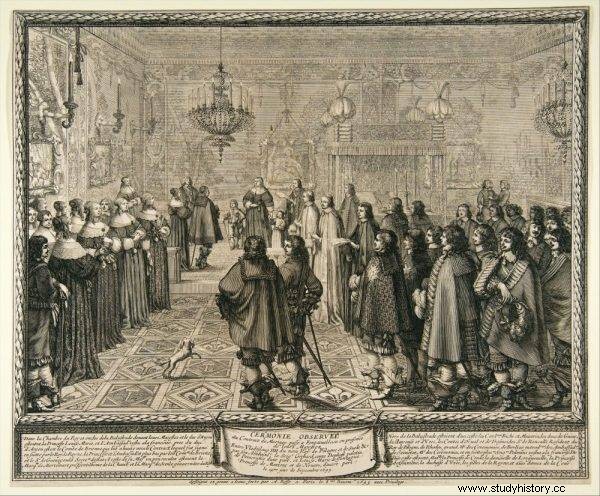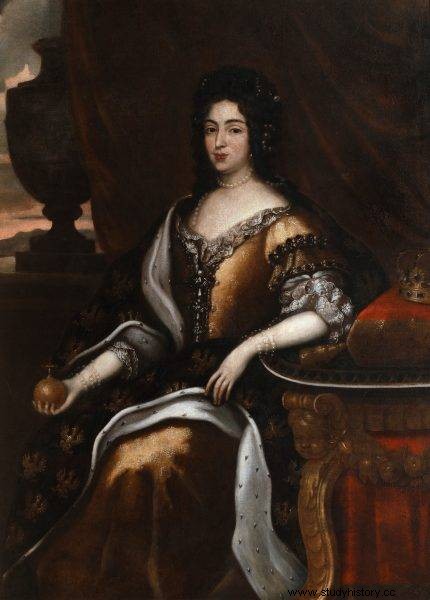When she sat on the throne, she had only her wits at her disposal in the struggle for influence. She quickly understood that the shortest path to political decisions of a Polish magnate ... was through his bed. She has formed a legion of beautiful and ruthless women. These "French flies" and their alkali talents were to make her the most powerful ruler of the age.
Ludwika Maria Gonzaga de Nevers, wife of two Polish Vasas and almost a sister-in-law of the King of France, was not beaten in the dark. From an early age, she had to find herself in the meanders of politics. She wasn't doing very well at first. Teen Ludwika Maria fell in love with the brother of the French king and in 1627 she was supposed to marry him. The sobering came quickly - at the monarch's will, Princess Gonzaga de Nevers ended up in a prison cell instead of wearing a wedding carpet.
An underappreciated weapon in the service of the Queen
When she married Władysław IV Waza in 1645, she was richer in these experiences and much more sensible. After arriving in Poland, she built a group of faithful supporters in the country from scratch. In addition to the usual methods of skilful diplomats, such as bribery, paying salaries to magnates, or mourning them with promises of honors and offices, she went a step further. The Queen used a weapon hitherto underestimated - female charms to gain influence.
With the arrival of Ludwika Maria to Warsaw, the city swarmed with her beautiful and attractive companions. For Poles visiting the court, it was quite a spectacle. Accustomed to the rather heavily built-up former Polish dresses, they simply could not take their eyes off the French women.

The ceremony of signing the wedding contract of Władysław IV and Ludwika Maria Gonzaga.
The queen's maids, like their mistress, were dressed in a Parisian fashion that was downright audacious . Just look at the portraits.
Neck, shoulders and half of the breasts on top, subtle pearls in the ears and neckline, and the face is framed with small curls. This outfit aroused the indignation of the Sarmatians who could not survive that:
The brides and matrons have lost all shame,
when, to the temptation of widows and married women, they show both their breasts and bare shoulders
(Wacław Potocki, quoted from:B. Fabiani, "Ludwiki Maria's Warsaw court")
The queen's maids, young, beautiful and blindly devoted to their mistress, very quickly became the eaters of men's hearts. Of course, Maria Ludwika did not plan to arrange a private brothel at the court and win over the crown lords in this way. Not at all! Everything was supposed to be "godly".
A marriage knot like political fetters
Of the mansions who came to the Vistula in the queen's retinue, many came from the impoverished French nobility. In their homeland, they had no prospects for promotion, career and position. Their future looked bright in Poland.
The condition was absolute loyalty to the queen and the court. If the courtiers were to make any career, the only way was through the graces of the monarch, which she knew how to use.
Ludwika Maria personally arranged the marriages of the ladies of the court and these marriages are wonderful. Each wedding was to be of her sole interest.

Portrait of Queen Louise Maria Gonzaga de Nevers attributed to Justus van Egmont
Trapped by a French, the Polish magnate, whether he wanted to or not, became an ally of the queen and the pro-French party. An example is the Pac couple.
A bride, Klara de Mailly-Lascaris, would not have a great marriage in her home country. She was so poor that she set off for the Vistula River with only a few clothes for her entire property . She came to Warsaw armed only with beauty, a dowry from the queen and the specter of future influence at the court for her potential spouse. It was enough.
In 1654 Klara became the wife of Krzysztof Zygmunt Pac, later the great Lithuanian chancellor, a powerful magnate. The libelers reluctant to such marriages added their three cents to it:
Eagle's head hurts from the foreigners,
They sprinkled it with flies at will,
Snaggy Chase to take tempora mali [times of evil - ed. ed.]
What they have already written about the differences.
Fic fac got married to Pac, took Miss Mali,
Pirvej married her rather than gave her to him.
As it turned out, the young Miss Klara, blessed with an angelic face and a strong character, wrapped around Pac like ivy. She perfectly fulfilled the task entrusted to her by the queen and connected her husband with the court with unbreakable bonds.
Love maneuvers with the desired effect
Pac was ready to support the queen, who made him happy with such a wife, in all his intentions and remained a faithful supporter of the court both during the Swedish deluge and during the civil war (Lubomirski's rebellion). Moreover, they got along so well with Klara that they were even partners in intrigues.
The queen's favorite, Jan Andrzej Morsztyn, was also caught in a marriage trap. It should be noted at once that he was never an opponent of France. Even more, he had a genuine affection for the lands on the Loire and the Seine and was loyal to their rulers.
The court poet sat in the pockets of French agents. Raised in the Francophile court of Ludwika Maria, his wife only deepened his devotion to the Sun King.

Portrait of Maria Kazimiera by Jan Tricius
Ludwika Maria married him to her mansion Katarzyna Gordon. Morsztyn had a high position at court and fortune, while the bride, a Scotswoman, had nothing. Such a wide range of material statuses was immediately exploited by malicious men. Bożena Fabiani in the book "The Warsaw Manor of Ludwiki Maria" even quotes a poem mocking this marriage:
Morsztyn Gordon gets it
Scots, triumph,
Needles, brushes and soaps
Boil the gifts.
In the long run, the queen's pet made the biggest career, which she brought to Poland when she was less than four years old. Maria Kazimiera d'Arquien was a beautiful child and came from an impoverished noble family, but grew up under the watchful eye of the queen.
When she grew up enough, Marysieńka became ... an award for fidelity to Jan Zamoyski. The powerful magnate did not abandon the king during the Swedish deluge and did not succumb to the army of Karol Gustaw besieging Zamość.
By the way, was also a Venerian, reveler and womanizer keeping his own harem. It does not change the fact that after the wedding he became an even closer ally of the court.
Marysieńka's next husband was also not a commoner. Jan Sobieski soon became the marshal after his marriage to the widowed Mrs. Zamoyska. At the same time, a clever wife, whom he loved deeply, directed his sentiments towards the queen as patron of their relationship.
The fate of two of the queen's courts - Klara Pac and Maria Kazimiera Sobieska - is presented in the latest novel by Robert Forys. After the death of Ludwika Maria, each of them was looking for their own way, which put them in enemy camps. Only Marysieńka remained loyal to France.
What about the nobility?
Ordinary nobles looked at these marriages and nibbled at the worried lumps of the robe. For their tastes, these French flies adorned their faces with bow ties were far too casual with men. In addition, even noble Polish virgins joined this collapse of morals.
The gentlemen did not like the marriage of poor French noblewomen in Polish magnate families. Their daughters could not be honored like this.
To make matters worse, as Bożena Fabiani writes, there was a conviction in the noble nation that the only one the road to high dignity leads through the bedrooms of the queen's court.
